Last summer, a buddy and I spent hours on the phone making plans for an autumn fly fishing trip. He was in Connecticut, which was dry as a bone and hotter than a bowl of Texas chili, and I was in Montana, which, if anything, was even worse. Our rivers were low and warm, the sun was an intimidating fixture in an endless blue sky, and the westerly breeze carried the constant acrid tang of distant forest fires burning in Washington and Oregon. Still, even though we were in the midst of another year of drought, and even though Montana’s fisheries were as dead as I’d ever seen them, I kept telling him not to worry.
“It’s going to be great.” I said. “As soon as it cools off, the fishing will pick right up.”
“You sure?” he’d ask.
“I’m sure.” And I was, because whether you’re sitting high in the Rockies, watching the first leaves turn back in New England, or wading a tiny spring creek in Wisconsin, the advent of fall brings the most consistent fly fishing of the year.
In a perfect world, autumn would last a full three months. After all, the calendar says that fall runs from the third week of September through the third week of December. In reality, though, Whitman’s “Ripe Breath Of Autumn”— with those cool nights, refreshing days and vibrant leaves — is the shortest of seasons, and it’s a lucky year when we get seven or eight weeks of that wonderful, soul stirring interlude between summer’s furnace and winter's snow.
When it comes to autumn, though, I’ll take whatever I can get, because in addition to bulging elk, cackling pheasants, and rutting bucks, fall ushers in the finest, most consistent, fly fishing of the year. And if you’ll forgive me for waxing poetic, compared to spring and summer with their hordes of anglers and unpredictable conditions, autumn fishing shines like the first hint of frost on a crimson-tinged maple leaf.
Three elements really help define fall fly fishing. First off, longer, cooler nights mean lower water temperatures, a welcome relief after the dog days of summer. Second, river flows are usually clear and stable. Third, hatches tend to last longer and they’re also more predictable. If you pay attention to all three and go to the river prepared for what you’re likely to encounter, your odds for success go way, way up.
Cool water means that the trout are actively feeding, and it also means that they’re feeding for longer periods during the day. Unlike summer angling, when the fish usually work at dawn and again at dusk, or winter angling, when they might wake up for an hour or two while the sun’s at its zenith, autumn trout take advantage of optimum water temperatures to eat all day long. To use a tennis racket as an analogy, fall, with it’s mix of cool water and comfortable daytime temps, has a much larger sweet spot than the seasons that bracket it. Consequently, you’ll have more opportunities at rising fish over the course of an average day, and this increase in opportunities will almost always result in more trout in the net.
Low, clear flows tell you where to look for fall trout, and what tackle to use. If the weather conditions are bright and sunny, trout will be in riffles where the broken water provides protection from predators and produces a veritable smorgasbord of aquatic food. They’ll also be next to cover — rocks and boulders, weed beds, drop-offs, ledges, and grassy or overhung banks — anyplace that provides both refuge and the occasional chance at an easy meal. If it’s an overcast or rainy day, the fish will spread out into slicks, pools and tailouts, and concentrate on any and all available surface insect activity.
As with other times of the year, you’ll need to adjust your autumn tackle for the conditions. A five weight rod that leaves you feeling undermanned during spring run-off could actually be too heavy for typical fall water levels. I believe a four weight is the best overall choice for most autumn fly fishing, and if your casts are short and wind isn’t a problem, a three weight can be an even better pick. Likewise, keep your leaders relatively long and light, and remember to exercise patience and stealth when you move in on rising trout.
Back when I fished New York and Connecticut all the time, fall angling meant Blue Winged Olives. The little olive-bodied, slate-winged mayflies were an autumn fixture on the Housatonic, the Farmington, the Beaverkill, and the Delaware, along with any number of small New England creeks that my friends and I frequented. When I moved west, I was stoked to find the same thing in Idaho and Montana. The diminutive mayflies were everywhere — tailwaters and spring creeks, freestones and mountain streams — and it didn’t take me long to figure out that Rocky Mountain rainbows and browns like them every bit as much as eastern trout. Consequently, if you have a couple dozen small BWO dries in your box, as well as a few pheasant tail nymphs to imitate the subsurface version of the insect, you’re in excellent shape.
In fact, you can catch autumn trout all over America with the most basic (if imprecise) olive pattern in the world — the Adams. Fish it in a size 18 or 20, and if your success isn’t all you’d hope for, or if you suspect that the trout are keying on emerging mayflies, grease your dry with a little extra floatant, tie a 16” dropper off the bend of the hook, and hang a unweighted size 18 pheasant tail on the tag end.
Of course, there are other aquatic insect patterns that can produce well in the fall, and terrestrials like beetles and ants can also be effective, but if you’re looking for autumn trout it makes sense to have your Olives covered before you head to the river.
When my buddy and I were planning our autumn jaunt, he kept asking me about fly patterns and sizes. He probably got tired of hearing my answers, which never, ever changed — Adams and Parachute Adams for the rivers that don’t see much pressure; Blue Winged Olive parachutes, sparkle duns, CDC emergers and cripples for the tougher fish; 18s and 20s would cover 90% of the situations we’d run across — but what could I say? If you’re hitting against Nolan Ryan, you better look for a fastball; if you’re fishing for fall trout, you better look for Olives.
As it turned out, the big problem with fall angling in the Rockies wasn’t finding a good place to fish, it was deciding which excellent rivers to pass up. There just wasn’t time to try them all. When my friend eventually arrived in Bozeman during the last week of September, we hit the lower Henry’s Fork, near Ashton, ID, which was full of big rainbows rising to Blue Winged Olives. Same thing on the Madison near West Yellowstone, MT, and on the Yellowstone River in Yellowstone Park. In fact, the Yellowstone’s trout couldn’t decide between huge Chernobyl Ants and little BWOs, so we kept feeding them both. Just thinking about it makes my elbow ache all over again.
Then it was on to a tributary of the Missouri River, where we caught dozens and dozens of nice rainbows and browns. On — that’s right, you guessed it — olives. My buddy didn’t want to leave that little creek — he kept mumbling something that sounded like “Heaven, I’ve finally found heaven” — but we still had the Missouri itself to explore. Where, if you’ll forgive the redundancy, we found even more muscular rainbows and browns sliding up through the low, clear water to sip size 20 blue winged olives off the river’s smooth surface.
Painful as it is to admit, even with two months of preparation time, we ran low on Olives and we had to take a few hours off from fishing to replenish our supplies at the vice.
Now I won’t lie to you and say that fall fishing is always easy. Because of the clear water conditions and the fact that the season has already been open for months, the trout aren’t pushovers. The hardest thing for me, though, is breathing in that cool autumn air and forcing away thoughts of pheasant hunting with my golden retrievers, or bowhunting for elk along a dark, timbered ridge. Fall has always been hunting season and when that call resonates in your blood it’s almost impossible to concentrate on anything else.
Still, as I sat on the banks of the Missouri, luxuriating in the late September sunshine and watching my friend play yet one more huge tail-walking rainbow, I couldn’t think of anyplace I’d rather be. The conditions were perfect, trout were rising for hundreds of yards up and down the river, and except for my angling partner, there wasn’t another soul in sight. Even the aspen that lined the canyons were an unusually rich shade of gold. If it wasn’t heaven, it was awfully damn close.




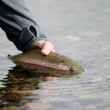

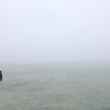


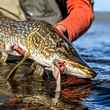

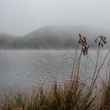
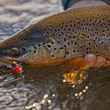

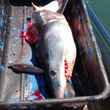

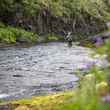
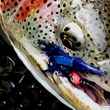


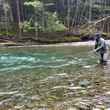

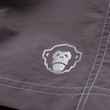


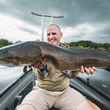
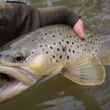
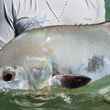
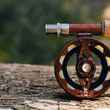
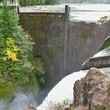

Comments
Les Bouck replied on Permalink
Great essay! Enjoying Fall fishing so far!! :-)
Mark Hayes replied on Permalink
Love this article! It is useful on so many levels. Clearly the author is a dry fly aficionado, as am I so overall philosophy really resonates with me. I also am a firm believer in bringing the right tool for the job. A 5wt can be overkill unless you plan to throw streamers or a heavy nymph rig. Low fall flows and crystal clear water dictates long leaders, fine tippets and size 18-22 baetis patterns. The 4wt is a much better choice and the 3wt might be ideal as you try to place the odds of a stealth approach in your favor. Nice work!
-Bolderado
Pages